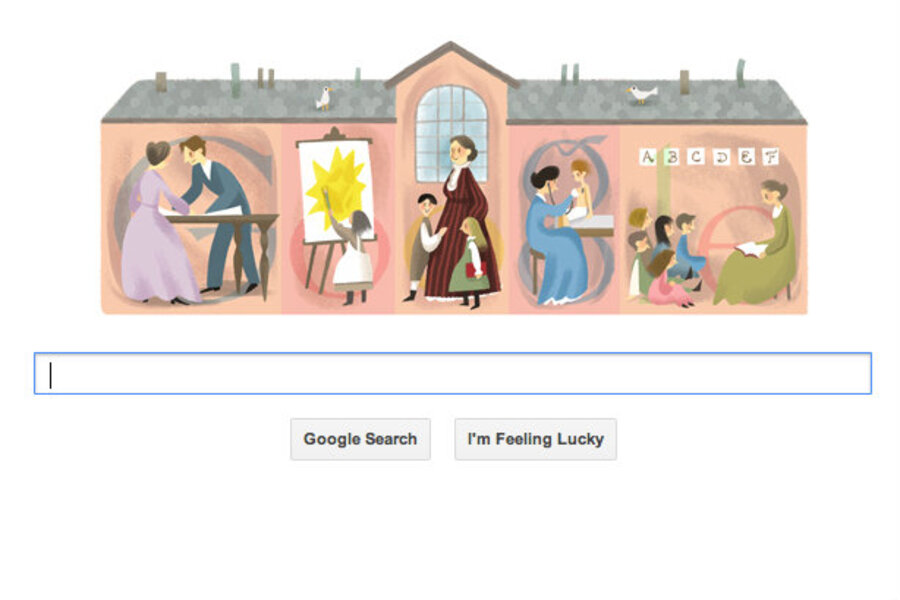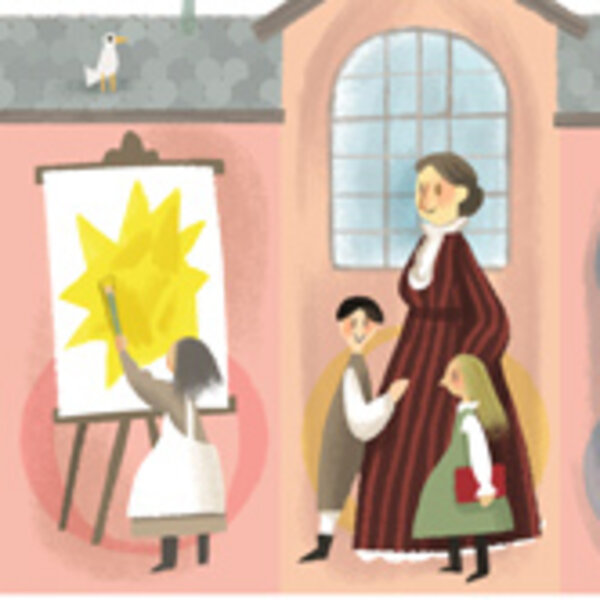Jane Addams Hull House brought to digital life on Google
Loading...
On busy Halsted Street in the Near West Side of Chicago, the Jane Addams Hull House is nestled in a corner of the University of Illinois-Chicago campus, just a quaint Victorian-style home, leafy courtyard, and empty dining hall.
But the historical significance of this house, and its founder, Jane Addams, lives on in the fields of sociology, feminism, pacifism, and education to this day.
And today, the Hull House got a second life in digital form. In honor of the 153rd birthday of Ms. Addams, Google created an online Hull House as its home page logo.
The doodle depicts a cheery red house with a gray roof. Inside, two students discuss research, a child paints, a woman (presumably Addams) chats with two children, a woman doctor checks on a patient, and a teacher reads to children. These were a few of the many functions of the Hull House: a place for scholars to study sociology and social work, a place where children were accepted and encouraged to create, a resource for health and education in the neighborhood. Today, these seem like normal social services. At the time, this was revolutionary.
The Hull House was the first American settlement house, created by Addams and Ellen Gates Starr in 1889. They originally met at Rockford Female Seminary in Rockford, Ill., and later traveled together to Europe. While in London, they visited Toynbee Hall, a center with social services for the poor in the East End neighborhood. Inspired by its method of creating a center of resources for the poor in needy areas, Addams and Ms. Starr returned to Chicago, intent on replicating the idea in the US.
When the women first set up Hull House (named for the builder, Charles Hull), the Near West Side was not the hip, college neighborhood it is today. It was a densely populated urban center; its residents were recent Italian, Irish, German, Bohemian, Greek, Russian, and Polish immigrants, many of whom worked in local factories and stockyards. Later, the neighborhood also became home to many African-Americans and Mexican immigrants. Many neighborhood residents had little education or livelihood, and even less social capital.
The Hull House revolutionized these socioeconomic norms by bringing a wealth of resources to the neighborhood. They hosted clubs for children and night classes for adults, offered health services, and added a swimming pool, art gallery, public kitchen, gym, music school, summer camp, and circulating library among other resources as the years went on.
Wealthy, educated scholars lived (called “settling”) in the settlement and studied the issues of the urban poor. This led to several powerful reform movements including the Immigrants’ Protective League, the Juvenile Protective Association, the first juvenile court in the nation, and protective legislation for women and children, especially in labor (take a peek at Upton Sinclair’s “The Jungle” for an idea of the labor standards at the time). But their duties were not solely policy-based. Jean Bethke Elshtain writes in "Jane Addams and the Dream of American Democracy," "If you were a resident, it would not be at all unusual to move over the course of a day from reading George Eliot, to debating Karl Marx, to washing newborns, to readying the dead for burial, to nursing the sick, to minding the children."
This work, among other major advances in women’s suffrage and pacifism, earned Addams the Nobel Peace Prize in 1931.
Though the Hull House ushered in a new era and method of social services, it hasn’t maintained the success it once had. The complex, at one time 13 buildings, was mostly demolished with the building of the University of Illinois-Chicago campus. The house, courtyard, and dining hall remain, and are now a museum devoted to Addams’s legacy.
The Jane Addams Hull House Association continued to provide social services to families across Chicago until 2012, when it filed for bankruptcy because of rising costs and declining funds after 123 years of service. It was providing assistance to 60,000 people per year in the Chicago area.









